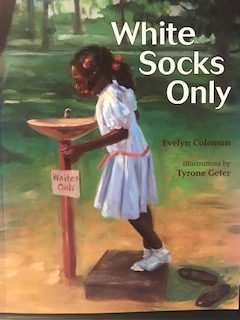
Title: White Socks Only
Author: Evelyn Coleman
Illustrator: Tyrone Geter
Publisher: Albert Whitman & Company
Year: 1996
Number of Pages: 32
Tags: Culture, Diversity, Emotion, Family, Historical fiction, Picture Book, K-5, Taylor Krueger
Genre: Historical Fiction Children’s Book
Analysis: This book shares the experience of a young girl’s Grandma in Mississippi during her childhood. One day she went into town to see if it was hot enough to fry an egg on the sidewalk. During this time period segregation was apparent in the South. While out in town she saw a “Whites Only” sign on a water fountain, so she took her shoes off and stepped up for a drink in her white socks. She misunderstood the sign, so it was her innocence that set the response of others in motion. This brave experience sparked an argument based on hatred of color. She showed that bravery and some help from a magical friend could overcome hate.
The illustrations of this book are bordered by the edge of the page. The illustrations are fuzzy and have large visible strokes of color. This gives the images depth and a different perspective from the reader. The reader is viewing the illustrations from near the main character almost as though the reader is right in the scene. There are moments  throughout the scenes where the reader seems to be viewing the actions of the characters from afar. The illustrations allow the reader to peer through a window into this time period of racism in the South. They have the reader feel the emotions of the main character during her trip to town. Thus there is a connection of empathy toward and fear for the young girl.
throughout the scenes where the reader seems to be viewing the actions of the characters from afar. The illustrations allow the reader to peer through a window into this time period of racism in the South. They have the reader feel the emotions of the main character during her trip to town. Thus there is a connection of empathy toward and fear for the young girl.
The colors used throughout the book are soft and vibrant which give insight into the actions of the characters. The colors of the illustrations blend to the page that contain the text, which seems as if the image goes off the page. The use of brush strokes is apparent in all the illustrations giving them depth and a uniqueness.
There are many emotions that are shown through the facial expressions of the characters. The structure of the characters are depicted through the illustrations and add to the meaning of the text. Throughout the book the main character, Grandma, is shown to have the expressions of happiness, sadness, fearfulness, and confusion. She is perceived to be happy when she is walking into town and frying an egg on the sidewalk, and then sad and scared when she is confronted for taking a sip of water from the “whites only” drinking fountain. The main character is shown large in the illustrations where she is happy and enjoying the freedom in town as she seems to be confident. She is very small and lower on the page (in some illustrations actually lying on the ground) when she is confronted by a white male. The white male is shown to have the power as he is looking down at the young girl on the ground. The illustrations and text of the book share an ideology issue for the reader. Throughout the time of the book racism and segregation in the South was very prevalent. This book shows an example of how African Americans were treated during this time in history. The ideology of this book sends a strong message to the reader as they can experience the discomfort and uneasiness of the characters.
This book is a representation of a multimodal text as the words and illustrations interact to fill in the gaps for the reader. The text and illustrations elaborate the theme and important meaning of the book. The images are a visual representation of the words and allow the reader to further understand them. This book uses the images and text to send a strong informational message of history to a young audience.
